My SciELO
Services on Demand
Journal
Article
Indicators
-
 Cited by SciELO
Cited by SciELO
Related links
-
 Similars in
SciELO
Similars in
SciELO
Share
Revista Cubana de Ciencias Forestales
On-line version ISSN 2310-3469
Rev cubana ciencias forestales vol.10 no.1 Pinar del Río Jan.-Apr. 2022 Epub Apr 08, 2022
Original article
Structural subniche of Parachondria neglectus (Littorinimorpha: Annulariidae) in Manzanillo, Cuba
1Universidad de Granma (UDG). Granma, Cuba.
2Universidad de São Paulo (USP). Brasil.
3Universidad de Oriente (UO). Santiago de Cuba, Cuba.
4Centro Oriental de Ecosistemas y Biodiversidad (BIOECO). Cuba.
Parachondria neglectus is a terrestrial mollusk endemic of Cuba. This species constitutes the only report of the Annulariidae family in the municipality of Manzanillo, Granma province. In the present study, the temporal dynamics of the structural subniche of a population of P. neglectus was characterized. Thirty expeditions were carried out between December 2013 and February 2015. 83.9 % of the mollusks were found on the ground (around the base of trees and shrubs) and 16.1 % used the trunk of eight plant species as diurnal resting substrate. The test of independence performed using a 2×2 contingency table with Yates correction showed that in the population the frequency of using one substrate or another depends on the occurrence or not of rainfall (χ2 = 214.88; P = 0.0001). This species was found at an average trunk distance of 13 ± 6.42 cm. The C-index values indicated marked preference of this mollusk for Swietenia mahagoni during all climatic periods sampled. During the rainy season this species also showed statistically significant preferences for Cordia gerascanthus, Ehretia tinifolia and Bursera simaruba. For the population, the height above the ground presented a mean value of 153.5 ± 71.3 cm. The heights above the ground reached by this species on rainy and non-rainy days showed statistically significant differences (U = 21519.5; P < 0.001).
Keywords: Land snails; Ecological niche; Parachondria neglectus; Plant-animal relationship.
INTRODUCTION
The frequent speciation processes, which occur in most of the islands, are manifested in the high diversity of terrestrial mollusks of the Cuban archipelago, perhaps as in no other group of the Cuban fauna. Evidence of this are the 476 terrestrial species of Neritimorpha and Caenogastropoda described for Cuba, with an endemism of 99.1 % (Hernández et al., 2018).
Of the six families of Cuban terrestrial mollusks, currently arranged in Neritimorpha and Caenogastropoda, Annulariidae is the most extensive, with 352 species grouped in 37 genera (Hernández et al., 2018). According to the catalog of Espinosa and Ortea (1999) this family in Granma is represented by 19 species included in five genera (three endemic).
Inventories of Cuban terrestrial malacofauna currently available indicate that Parachondria (Parachondria neglectus) (Pfeiffer 1858) is presumably the only representative of this family in Manzanillo (Sariego 2010).
In this geographic area, excluding inland waters, the proportion covered by forest in relation to the total land area has been estimated at 27.1 % (ONEI 2018). Likewise, the extent of occurrence for this species does not exceed 1 091 km² (Sariego 2006). This confirms the importance of its ecological study for conservation purposes.
Terrestrial mollusks, due to the micro-localization and strict ecological requirements of many of their species, are ideal for biodiversity assessments and studies about the history of communities of organisms in space and time (Fontenla et al., 2013).
The ecological niche is a term widely used in ecological and evolutionary theory. It is a conception that attempts to represent the function of organisms in nature and their interactions with the environment (Fontenla 2001). Its study is of great importance to understand the interactions and competitive relationships of species. It also provides important elements for the management and conservation of fauna. According to Silva and Berovides (1982), the determination of the ecological niche should be the central unit of population studies, including terrestrial mollusks.
In order to plan restoration projects or to make conservation decisions, it is essential to have baseline information as well as reference data to develop statistically reliable temporal analyses and predictions. Long-term observations are necessary to answer theoretical questions in ecology, such as reducing uncertainties about the irreversibility of structural changes and ensuring the success of restoration and conservation programs (Díaz-Delgado, 2016).
For the above reasons, the present study characterized the temporal dynamics of the structural subniche of a population of P. neglectus in the municipality of Manzanillo, Granma province, Cuba.
MATERIALS AND METHODS
Study area
The municipality of Manzanillo located in the province of Granma has a surface area of 498.95 km2 (ONEI, 2017) and is located in the Cauto-Guacanayabo plain. The city is bordered by limestone heights of up to 80 masl and the southern end of the municipal territory goes into the foothills of the Sierra Maestra (Sariego 2010). The locality studied is located between 20°20'29.77''N -77°05'00.37''W, belongs to the Blanquizal village and has an approximate area of 20 500 m2. Its floristic characterization was carried out in the herbarium of the Eastern Center of Ecosystems and Biodiversity (BIOECO) and it is part of the results of this study. The criteria of Greuter and Rankin (2016) were used for the order and nomenclature of the species and botanical families.
Structural subniche of P. neglectus
The terminology used for the study of the structural subniche is that suggested by Silva and Berovides (1982), taking into account the subdivisions proposed by Berovides et al. (1988). The presence of the retracted peristome allowed the identification of adults. To characterize the temporal dynamics of the structural sub-niche of the P. neglectus population, two monthly samplings were carried out (in 3 x 3 m plots) during the period from December 2013 to February 2015.
Daytime resting substrates
The specimens observed on the ground and on the trunks of trees and shrubs in the locality were quantified to determine the preferential substrate of the population, as well as their monthly frequency of use.
Distance from the trunks
In all specimens that used soil as substrate, the distance from the trunk, which was measured from the region of the shell closest to the base of the tree, was determined in (cm) with a three-meter professional Thorsen flexometer.
Height above ground and strata
In the mollusks that were observed on the trunk of trees and shrubs, the height above the ground was measured in centimeters as well. The individual data of heights above ground were grouped into the following classes or strata: I- (0.1 to 50 cm), II- (50.1 to 100 cm), III- (100.1 to 150 cm), IV- (150.1 to 200 cm), V- (200.1 to 250 cm), VI- (250.1 to 300 cm), VII- (300.1 to 350 cm) and VIII- (350.1 to 400 cm).
Plant-animal relationship
The study was carried out through direct observation of the individuals and the species of plant that served as substrate. Paths were taken to determine the plants used by P. neglectus. The methodology used by Reyes-Tur (2004) was followed in order to study the seasonal dynamics of the availability and use of plant species. During each sampling, 50 points were randomly selected throughout the work area. At each point, a 3 m long and 5 cm wide bar was placed and the contacts of the bar with the different plant species, available used as resting substrate, were noted. In addition, to determine the number of times each plant was used, observations, made within the work area but outside the selected points, were considered. From the data collected, the C index (Pearre 1982) was calculated for the plant species used as substrate by P. neglectus. This index was calculated according to the formula (Equation 1).
Where Ad is the number of individuals of species A used as resting substrate; Am is the number of individuals of species A available; Bd is the number of individuals of the rest of the species used as resting substrate; Bm is the number of individuals of the rest of the species available; A equals Ad + Am ; B equals Bd + Bm ; D equals Ad + Bd ; M equals Am + Bm and n equals Ad + Bd + Am + Bm.
The C index, based on ÷2 allows the significance of the degree of preference or rejection to be established for any sample size. Its value ranges from -1 to +1, positive values indicate preference, negative values indicate rejection, and C = 0 indicates random use. The significance criterion for this test was P < 0.05. Tabulated values of ÷2 were used with one degree of freedom as suggested by Pearre (1982), Pearre (2011).
The values of this index were determined taking into account rainy and low rainfall seasons. To establish both periods, the monthly average values of millimeters of rainfall reported by the Manzanillo Meteorological Station and published by ONEI (2017) were analyzed. The study covered the following periods: low rainfall period (December 2013 to April 2014), rainy period (May to October 2014), low rainfall period (November 2014 to February 2015).
All statistical calculations were performed with the STATISTICA 13.0 program (Statsoft 2015). Through the calculation of the mean, standard deviation and coefficient of variation, the distances to the trunk and the heights above the ground of the mollusks were statistically characterized. A test of independence was carried out with a 2 x 2 contingency table with Yates correction to determine whether the frequency of use of one substrate or another depends on the occurrence or not of rainfall in the population studied. The Kolmogorov-Smirnov test was used to analyze the distributions by substrate in both juvenile and adult individuals. The Mann-Whitney U test allowed to compare the distances from the trunk between juvenile and adult individuals, as well as the distances from the trunk and the heights above the ground reached by this species in the rainy and low rainfall periods on a monthly basis.
RESULTS AND DISCUSSION
Daytime resting substrates
In general, 83.9 % of the individuals were detected on the ground, around the base of trees and shrubs, the rest used trunks as a diurnal resting substrate. The monthly frequency of this species on both substrates is shown in Figure 1. Although ground use was higher, the highest proportion of individuals on this substrate was recorded in October 2014 (Figure 1).
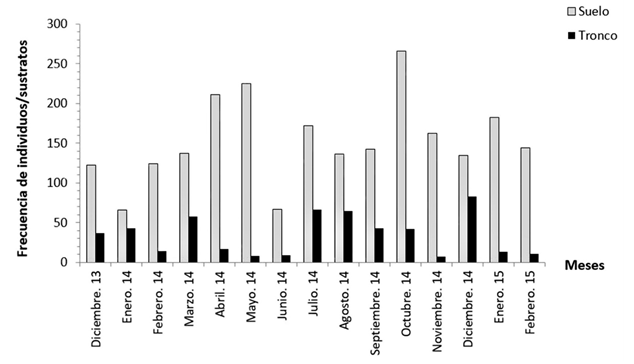
Fig. 1. - Monthly frequency by substrate of individuals of the studied population of P. neglectus in Manzanillo
The Kolmogorov-Smirnov test indicated the existence of significant statistical differences between the distributions of juveniles on soil and trunk (DN = 0.87; P = 0.0003). In adults, there were also significant statistical differences during the analysis of substrate distributions (DN = 0.82; P = 0.0001). However, no statistical differences were found related to soil usage by juveniles and adults (DN = 0.45; P = 0.18). There were also no significant statistical differences in trunk utilization by both age groups (DN = 0.37; P = 0.24).
The test of independence performed by means of a 2×2 contingency table with Yates correction showed that in the population the frequency of substrate usage depends on the occurrence or not of rainfall (÷2 = 214.88; P = 0.0001).
During the field work, mollusks of Parachondria neglectus were never observed on the stones, as found by Gundlach in this same municipality, according to Arango (1878) referring to the synonym Chondropoma revinctum (Poey in Pfeiffer 1858). The genus Chondropoma was already reported by Mesa (1986) within the classification of arboreal mollusks of Cuba. In the book of terrestrial mollusks of Cuba by Espinosa and Ortea (2009), subsequent to the most updated revision of terrestrial mollusks of this family in the Caribbean (Watters, 2006), this species is mentioned under the name Chondropoma neglectum (Gundlach in Pfeiffer 1856).
Nevertheless, these authors report that many species of terrestrial mollusks are capable of adapting to the temporary occupation of space according to the vital needs of their biological cycle, the earth, stones and vegetation can be part of their life cycle.
Soil substrate
Distance from the trunk
The mean distance to the trunk was 13 ± 6.42 cm. 22.7 % of the mollusks were observed around and at the base of trees and shrubs. Temporal variation in distances to the trunk of juveniles and adults (Table 1).
Table 1. - Temporal variation of distances to the trunk (cm) of juvenile and adult individuals of the studied population of P. neglectus in Manzanillo
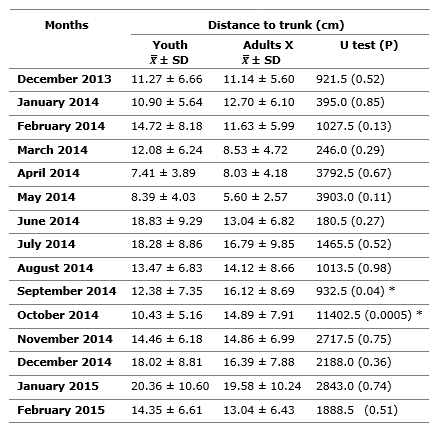
X: - Mean, DS - standard deviation. U test: Mann-Whitney U test with associated probability, * significant differences at 5 %
Only in the months of September and October 2014 the distances to the trunk between the two age groups were statistically different. The results of the Mann-Whitney U Test indicated that, in the rainy and low rainfall periods, the distances from the trunk for the population were not statistically significant (U = 472; P = 0.11).
According to Sariego et al. (2018) for this species the trunk of shrubs and trees is the preferential substrate for reproduction. These authors indicated that in the months of September and October occurred the recruitment period in the population. From the above, it is possible to infer that the significant statistical differences between the distances to the trunk of juveniles and adults. These two months could indicate that egg hatching occurs more successfully in favorable conditions at the base of trees and shrubs.
Substrate trunk
Height above ground and strata
The height above the ground showed a mean value of 153.5 ± 71.3 cm and a maximum of 394 cm. During rainy days, the frequency of P. neglectus mollusks on the trunk increased. A greater number of active individuals was also observed on this substrate (Figure 2).
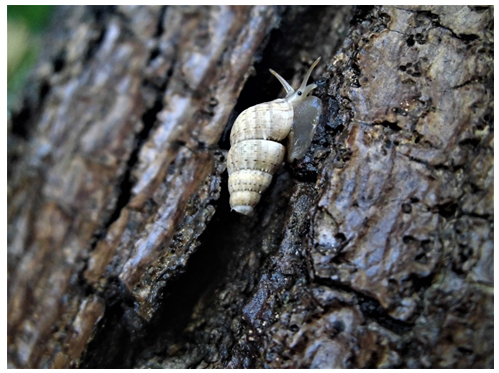
Fig. 2. - Illustrative image of the external morphology of P. neglectus during diurnal activity on the trunk of Swietenia mahagoni favored by rainfall at the locality
Juveniles showed a preference for the lowest stratum (55.6 %) and occupied five of the eight established strata. Twenty-five percent of the adults were concentrated in stratum IV. In general, adults were distributed on the trunk occupying all strata (Figure 3). The heights above the ground reached by this species on rainy and non-rainy days showed statistically significant differences (U = 21519.5; P < 0.001) (Figure 3).
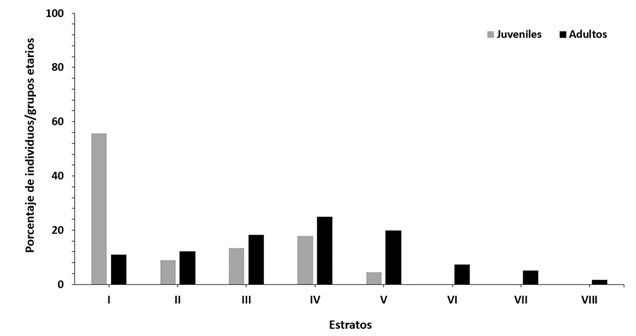
Fig. 3. - Percentage of juvenile and adult individuals by strata in the trunk of trees and shrubs used by P. neglectus in the studied locality
During diurnal rest, individuals were observed attached to the trunk by a short band of dry mucus (no longer than two millimeters) with visible longitudinal folds extending from the substrate along the inner surface of the shell to the operculum. According to Watters (2014), the propensity of mollusks of this family to suspend themselves from mucous threads has been reported for species from Jamaica, Haiti, Dominican Republic, the Netherlands Antilles and Cuba. The author also suggested that this behavior could indicate a very ancient trait of an antipredator strategy or a strategy to dissipate heat.
From the energetic point of view, the locomotion of mollusks is slow and complex due to the secretion of mucus. Taking this criterion into account, it is logical to interpret that in favorable conditions of temperature and humidity, their activity and ascent up the trunk increases. It has also been reported that in some species of terrestrial mollusks, the daily and annual activity cycles are synchronized and interact with various environmental factors (Reyes-Tur et al., 2018).
The climatic periods studied and established according to reports by ONEI (2017) for Manzanillo coincided with the two well-defined seasonal periods throughout the Cuban territory. A rainy one that runs from May to October and a low rainfall one that extends from November to April (Durán 2016)..
Plant-animal relationship
The floristic inventory of the studied locality allowed the identification of 35 species (19 families) of higher plants (16 herbaceous, 5 lianas, 1 epiphyte, 8 shrubs and 5 trees). However, P. neglectus was observed on 8 plant species (5 trees and 3 shrubs) as a diurnal resting substrate.
The C index values showed significant preference for Swietenia mahagoni during all the climatic periods sampled. For Cordia gerascanthus, Ehretia tinifolia and Bursera simaruba there were statistically significant preferences in the rainy period. In the low rainfall period for these three species, as well as for Gastrococos crispa, Bourreria virgata, B. taylorii and Pisonia aculeata (in all climatic periods) the values of the C index were not significant (C, P > 0.05) (Table 2).
Terrestrial gastropods have numerous plant species in their environment, of which they can use the trunk as a resting and/or feeding substrate, which is why they are usually considered generalist herbivores (Reyes-Tur 2004).
Regardless of this generalist behavior in relation to the use of plants as resting substrates, there are species capable of developing life strategies in terms of plant preference and rejection. The characteristics of these strategies are mainly related to the availability of plant species and their physical features (morpho-anatomical) (Reyes-Tur 2004).
In the locality studied, P. negletus showed a preference for three tree species and one large shrub. However, the preference found for large plants cannot be considered a peculiarity of the species. It has been observed in other localities in Manzanillo associated with erect poaceae, as well as the following plant species: Amphilophium gnaphalanthum (liana), Turbina corymbosa (climber), Leucaena leucocephala (shrub), Sideroxylon foetidissimum (tree) and Cocos nucifera (tree) (Sariego 2010) (Table 2).
Table 2. - Floristic list of families and species with the values of the C index (Pearre 1982) for plant taxa used by P. neglectus in the studied locality
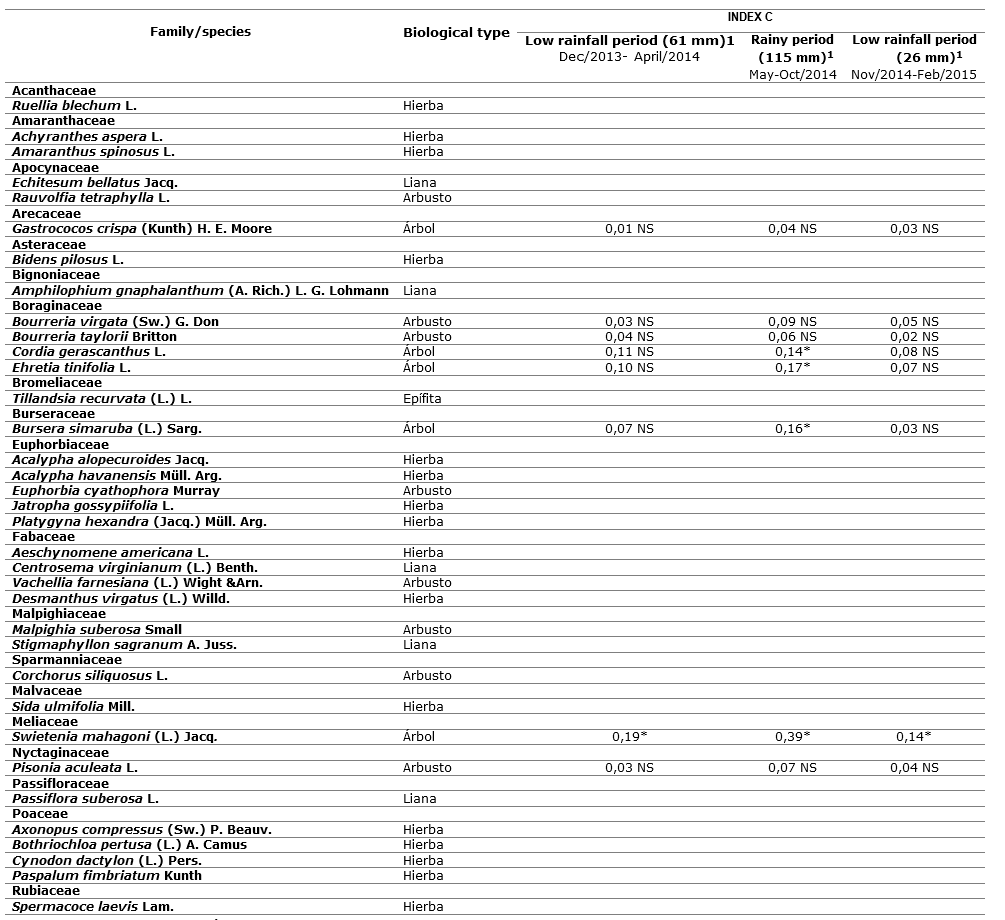
NS: no statistical significance; *: P < 0.05;1: Monthly average of accumulated mm of rainfall in Manzanillo in the studied climatic periods obtained from ONEI (2017).
CONCLUSIONS
According to the observations made on the use of substrates in the locality studied in the municipality of Manzanillo, Granma, it is possible to infer that P. neglectus is a terrestrial mollusk associated with vegetation.
In the studied population of P. neglectus, the frequency of utilization of one substrate or another depended on the occurrence or not of rainfall; under favorable conditions of temperature and humidity these mollusks increased their activity and ascent up to the trunk.
The C index values showed significant preference of P. neglectus for Swietenia mahagoni (mahogany) during all climatic periods sampled. For Cordia gerascanthus, Ehretia tinifolia and Bursera simaruba there were statistically significant preferences in the rainy period.
REFERENCIAS BIBLIOGRÁFICAS
ARANGO Y MOLINA, R., 1878. Contribucion a la fauna malacologiea cubana, [en línea]. Habana: Imp. de G. Montiel y comp. Disponible en: https://www.worldcat.org/title/contribucion-a-la-fauna-malacologiea-cubana/oclc/1556892. [ Links ]
BEROVIDES, V., GENARO, J.A. y SÁNCHEZ, C.S., 1988. Nuevas consideraciones acerca del nicho ecológico. Ciencias Biológicas [en línea], vol. 19, no. 20, pp. 3-8. Disponible en: http://repositorio.geotech.cu/jspui/bitstream/1234/2838/1/Nuevas%20consideraciones%20nicho%20ecol%C3%B3gico.pdf. [ Links ]
DÍAZ-DELGADO, R., 2016. La Investigación y Seguimiento Ecológico a Largo Plazo (LTER): Ecosistemas [en línea], vol. 25, no. 1, pp. 1-3. [Consulta: 09/04/2022]. ISSN 1697-2473. DOI 10.7818/ECOS.2016.25-1.01. Disponible en: Disponible en: https://www.revistaecosistemas.net/index.php/ecosistemas/article/view/1188 . [ Links ]
ESPINOSA, J. y ORTEA, J., 1999. Moluscos terrestres del archipiélago cubano. Avicennia [en línea], vol. 2, pp. 1-137. Disponible en: https://www.researchgate.net/profile/Jesus-Ortea-Rato/publication /294736627_Terrestrial_molluscs_from_the_cuban_archipelago/links /56c3a1f808aee3dcd4166978/Terrestrial-molluscs-from-the-cuban-archipelago.pdf. [ Links ]
ESPINOSA, J. y ORTEA RATO, J., 2009. Moluscos Terrestres de Cuba [en línea]. S.l.: s.n. ISBN 978-952-92-5427-9. Disponible en: https://www.researchgate.net/publication/296847933_Moluscos_Terrestres_de_Cuba. [ Links ]
FONTENLA, J.L., 2001. Sobre el nicho ecológico. Cocuyo [en línea], vol. 10, pp. 26-33. Disponible en: http://www.bio-nica.info/biblioteca/cocuyo2001no10.pdf. [ Links ]
FRÓMETA, S.S., TAMAYO, O.R.S., MORÁN, J.E.M. y SIMONE, L.R.L., 2018. Subnicho etario y biología reproductiva de Parachondria neglectus (Littorinimorpha: Annulariidae) en Manzanillo, Cuba. Revista de Biología Tropical [en línea], vol. 66, no. 4, pp. 1664-1673. [Consulta:09/04/2022]. Disponible en: Disponible en: https://www.redalyc.org/journal/449/44959684026/movil/ . [ Links ]
GREUTER, W. y RANKIN, R., 2016. Espermatófitos de Cuba. Inventario preliminar [en línea]. S.l.: Botanischer Garten & Botanisches Museum Berlin-Dahlem & Jardín Botánico Nacional, Universidad de La Habana. Disponible en: https://www.bgbm.org/sites/default/files/bgbm-press/Greuter-Rankin-et-al_2016-04-05.pdf. [ Links ]
HERNÁNDEZ, M., ALVAREZ-LAJONCHERE, L., MARTÍNEZ BORREGO, D., MACEIRA, D., VELÁZQUEZ, A. y SÁEZ, J., 2018. Moluscos terrestres y dulceacuícolas. Diversidad biológica de Cuba: métodos de inventario, monitoreo y colecciones biológicas [en línea]. La Habana, Cuba: Editorial AMA, ISBN 978-959-300-130-4. Disponible en: https://www.researchgate.net/publication/324923726_Moluscos_terrestres_y_dulceacuicolas. [ Links ]
Sifford, Pearre Jr., 2011. Estimating Prey Preference by Predators: Uses of Various Indices, and a Proposal of Another Based on ?? Canadian Journal of Fisheries and Aquatic Sciences, vol. 39, pp. 914-923. DOI 10.1139/f82-122. [ Links ]
LLACER, I.D., 2016. Cantidad de días con lluvia y su distribución por intervalos en condiciones normales y de sequía severa en el occidente de Cuba. Revista Cubana de Meteorología [en línea], vol. 22, no. 1, pp. 49-65. [Consulta: 09/04/2022]. ISSN 2664-0880. Disponible en: Disponible en: http://rcm.insmet.cu/index.php/rcm/article/view/208 . [ Links ]
MESA GARCÍA, R., 1986. Moluscos arborícolas y asociados con la vegetación en Cuba. Rev. cuba. med. trop [en línea], vol. 38, no. 3, pp. 335-41. [Consulta: 09/04/2022]. ISSN 0375-0760. Disponible en: Disponible en: http://bases.bireme.br/cgi-bin/wxislind.exe/iah/online/?IsisScript=iah/iah.xis&src=google&base=LILACS&lang=p&nextAction=lnk&exprSearch=52293&indexSearch=ID . [ Links ]
ONEI (OFICINA NACIONAL DE ESTADÍSTICA E INFORMACIÓN DE LA REPÚBLICA DE CUBA), 2017. Anuario Estadístico de Manzanillo 2016 [en línea]. S.l.: ONEI. Disponible en: http://www.one.cu/aed2016/33Granma/Municipios/06%20Manzanillo.pdf. [ Links ]
ONEI (OFICINA NACIONAL DE ESTADÍSTICA E INFORMACIÓN DE LA REPÚBLICA DE CUBA), 2018. Panorama Ambiental Cuba 2017. Edición junio de 2018 [en línea]. S.l.: Centro de Gestión de la Información Económica, Medioambiental y Social. Disponible en: http://www.one.cu/publicaciones/04industria/medioambientecifras/medioamb2017.pdf. [ Links ]
REYES-TUR, B., FLORES-RICARDO, L.A. y FERNÁNDEZ-VELÁZQUEZ, A., 2018. Actividad diaria de Polymita muscarum (Gastropoda: Cepolidae) en un agroecosistema: relación con factores climáticos y duración del apareamiento / Daily activity of Polymita muscarum (Gastropoda: Cepolidae) in an agroecosystem: relationship with climatic factors and mating duration. Revista Cubana de Ciencias Biológicas [en línea], vol. 6, no. 1, pp. 9. [Consulta: 09/04/2022]. ISSN 2307-695X. Disponible en: Disponible en: http://www.rccb.uh.cu/index.php/RCCB/article/view/219 . [ Links ]
RIZO, J.L.F., et al., 2013. Biogeografía histórica de los géneros endémicos de moluscos terrestres de Cuba. Determinación y relaciones entre sistemas biogeográficos. Revista de la Academia Canaria de Ciencias: = Folia Canariensis Academiae Scientiarum [en línea], vol. 25, no. 1 (Diciembre), pp. 141-162. [Consulta: 09/04/2022]. ISSN 1130-4723. Disponible en: Disponible en: https://dialnet.unirioja.es/servlet/articulo?codigo=4568248 . [ Links ]
SARIEGO, O.R., 2006. Acercamiento a la definición del estado de conservación de Chondropoma neglectum (Gundlach in Pfeiffer; 1856) (Annulariidae: Mollusca). Revista Electrónica Granma Ciencia [en línea], vol. 10, no. 2, pp. 1-14. [Consulta: 09/04/2022]. Disponible en: Disponible en: https://docplayer.es/91028995-Revista-electronica-granma-ciencia-vol-10-no-2-mayo-agosto-de-2006-issn-x.html . [ Links ]
SILVA, A.R. y BEROVIDES, V., 1982. Acerca del concepto de nicho ecológico. Ciencias Biológicas , vol. 8, pp. 95-103. [ Links ]
WATTERS, G.T., 2006. The Caribbean land snail family Annulariidae: a revision of the higher taxa and catalog of the species [en línea]. Leiden: Backhuys Publishers. ISBN 978-90-5782-155-4. Disponible en: https://www.worldcat.org/title/caribbean-land-snail-family-annulariidae-a-revision-of-the-higher-taxa-and-catalog-of-the-species/oclc/254321417. [ Links ]
WATTERS, G.T., 2014. A revision of the Annulariidae of Central America (Gastropoda: Littorinoidea). Zootaxa [en línea], vol. 3878, no. 4, pp. 1-350. [Consulta: 09/04/2022]. ISSN 1175-5334. DOI 10.11646/zootaxa.3878.4.1. Disponible en: Disponible en: https://www.biotaxa.org/Zootaxa/article/view/zootaxa.3878.4.1 . [ Links ]
Received: March 19, 2021; Accepted: April 07, 2022











 text in
text in 




